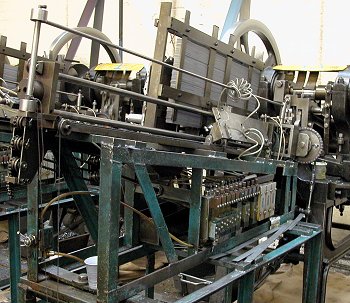
| A close-up view of
one of the automatic feeds in operation. The magazine at
the top holds between 100 and 150 of the steel strips,
which are automatically fed into the press at the back. |
|
By this time Ken Farrington had taken over as
Works Manager and he was giving due consideration to the
problem.
He knew Ron Turner, a skilled toolmaker, and one evening
over a drink he mentioned the problem to Ron, who decided to
come and have a look for himself.
After inspecting the machines Ron came up with a few ideas
and Mr. Somerville gave him the go-ahead to develop a prototype.
At the time Bob Hawks was employed in the fitting shop. He had a
wonderful engineering background from his time at Guy Motors and
he helped Ron to build the first few prototypes. |